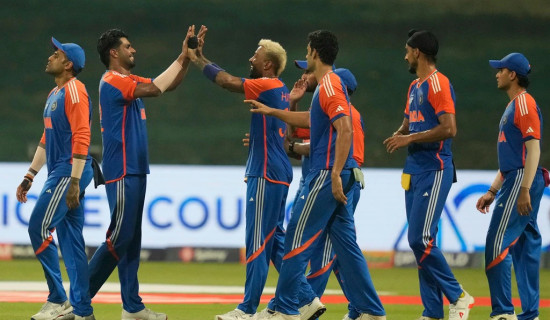- Saturday, 20 September 2025
Not all boxes ticked, but India get what they want from Oman contest
By Shashank Kishore, ESPNCRICINFO, Sept 20: As Hardik Pandya stopped himself a quarter of an inch before the advertising triangles at fine leg to complete a stunning catch to dismiss Oman's Aamir Kaleem, fielding coach T Dilip was full of fist-pumping joy in the dugout.
He had followed the trajectory of the ball like a hawk, silently hoping that hours of the innovative catching drills that had challenged fielders to be goalkeepers (even Superman at times), would lead to something spectacular. Sitting next to him, the usually stoic Gautam Gambhir had been frantically chewing his nails until then. The first two balls of the 18th over, bowled by Harshit Rana, had been picked away for boundaries, and the equation was down from 48 off 18 balls to 40 off 16.
Even then, you felt this was India's match to lose. But with their least experienced bowler pitted against a 43-year-old journeyman cricketer revelling in the spotlight, the coaches' restlessness spoke of the tension that had been bubbling. Oman eventually finished 21 short, but the contest offered India more than just a 'W' and two points.
For the first time in three games, India had the luxury of batting 20 overs, on a sluggish surface with ground dimensions far bigger than in Dubai, where they will play out the rest of their Asia Cup campaign.
It also stretched them on the field, with Suryakumar Yadav employing as many as eight bowling options - although he wouldn't have imagined having to make up for Axar Patel's overs at any point: Axar bowled just one over and was off the field for the last five-and-a-bit overs after hitting his head on the turf while attempting a catch.
That they were able to get such a workout in a setting where the focus was, for a change, entirely on the cricket, helped tick a few boxes. If a workout before the Super Four is what they had hoped for, they certainly got it.
India's middle-order batters, who had twiddled their thumbs in the first two games because they had polished off their chases of 58 and 128 in a combined 20.2 overs for a combined loss of four wickets, got a decent hit, even though none of them could set the stage alight.
Every batter, barring Suryakumar, who delayed his entry until the overs ran out, got time in the middle.
Suryakumar didn't bat because Arshdeep Singh, padded up and was itching for a hit, leaned in to his captain and declared he was going next when the seventh wicket fell. And then Kuldeep Yadav went in. India finished eight down, and Suryakumar had a "DNB" against his name. He revealed with his trademark humour later that it wasn't a request from Arshdeep but an instruction, one that had the potential to be viewed under a microscope had India been upset. Luckily, though, they were saved from that.
The only aspect India didn't experiment with in the batting was their locked-in opening pair of Shubman Gill and Abhishek Sharma. This is in line with what they have emphasised through the tournament: the need for the rest of the batters, from No. 3-8, to be flexible, while the openers remain set.
For once, though, India deviated from their set left-right policy. This gave Sanju Samson an opportunity at No. 3 after Gill was out early. Samson was scratchy at best, but batted long enough to carve out a half-century.
He was helped to a large extent by Abhishek, whose great strength has been to keep bowlers second-guessing. When he advances to fast bowlers, he has an array of options. Like the slice over point, the lofted hit over the covers, or the swat over mid-on - shots, he exhibited similar deliveries off Mohammed Nadeem in the fifth over.
This helped Samson ease in after he had struggled for any kind of fluency, pottering to 1 off 7 before finally breaking the shackles when he received a leg-stump half-volley that he flicked for six. That should have flicked a switch, but it didn't, underpinning the fact that nothing matches time in the middle, even if you look a million dollars in the nets.
Tilak Varma showed he can adapt lower down the order if required, hitting 29 off 18 balls. Axar flexed his batting muscle against spin, even as Hardik and Shivam Dube missed out. Hardik was the unluckier of the two, as he was run out to a deflection off the bowler's hand at the non-striker's end.
Then, with the ball, Arshdeep bent the new ball and got it to hold its line, but Harshit was erratic. Kuldeep was his usual self - befuddling batters even as two other wreckers-in-chief, Jasprit Bumrah and Varun Chakravarthy, ran drinks.
But the revealing aspect of India's workout was giving the new ball to Hardik despite having two frontline pacers - perhaps a sign that, like with the batting, they were focused on continuity, looking at the bigger picture.
The match itself was one of those exercises where India's follies were looked at indulgently, until it got too close for comfort.
In the Asia Cup circles around the UAE, the running joke ahead of Friday's game was whether India's commute from their Dubai hotel to the Zayed Cricket Stadium in Abu Dhabi would end up lasting longer than the match itself. The India vs UAE game had wrapped up in barely two hours, and a repeat was anticipated had Oman batted first.
But in pushing India right till the end, Oman not only enhanced their own credentials, but also injected some interest into a tournament that had been drifting from one controversy to another while seeing more than its fair share of one-sided contests.
For India, it was the closest thing to a dress rehearsal before the Super Four: it was imperfect in parts, yet valuable in every way ahead of round two against Pakistan on Sunday.

.jfif)

-original-thumb.jpg)

-square-thumb.jpg)





-original-thumb.jpg)
-original-thumb.jpg)

-original-thumb.jpg)
-original-thumb.jpg)